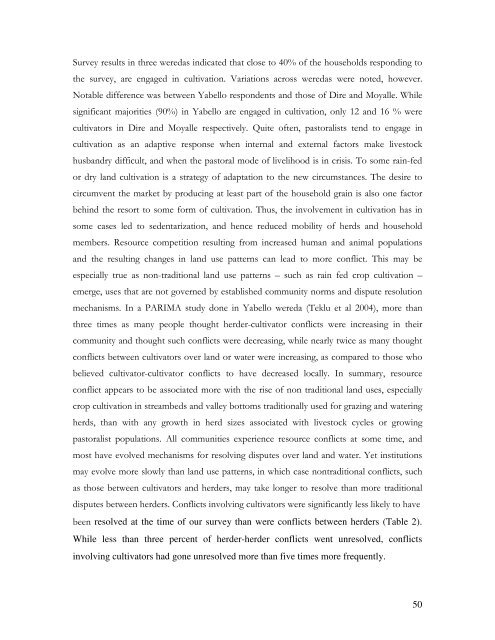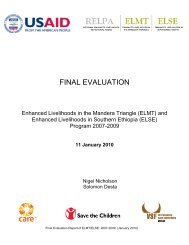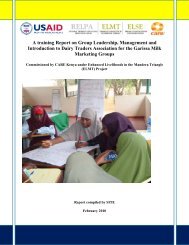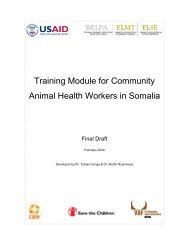care international in ethiopia – pastoral drop out study - ELMT Home
care international in ethiopia – pastoral drop out study - ELMT Home
care international in ethiopia – pastoral drop out study - ELMT Home
Create successful ePaper yourself
Turn your PDF publications into a flip-book with our unique Google optimized e-Paper software.
Survey results <strong>in</strong> three weredas <strong>in</strong>dicated that close to 40% of the households respond<strong>in</strong>g to<br />
the survey, are engaged <strong>in</strong> cultivation. Variations across weredas were noted, however.<br />
Notable difference was between Yabello respondents and those of Dire and Moyalle. While<br />
significant majorities (90%) <strong>in</strong> Yabello are engaged <strong>in</strong> cultivation, only 12 and 16 % were<br />
cultivators <strong>in</strong> Dire and Moyalle respectively. Quite often, <strong>pastoral</strong>ists tend to engage <strong>in</strong><br />
cultivation as an adaptive response when <strong>in</strong>ternal and external factors make livestock<br />
husbandry difficult, and when the <strong>pastoral</strong> mode of livelihood is <strong>in</strong> crisis. To some ra<strong>in</strong>-fed<br />
or dry land cultivation is a strategy of adaptation to the new circumstances. The desire to<br />
circumvent the market by produc<strong>in</strong>g at least part of the household gra<strong>in</strong> is also one factor<br />
beh<strong>in</strong>d the resort to some form of cultivation. Thus, the <strong>in</strong>volvement <strong>in</strong> cultivation has <strong>in</strong><br />
some cases led to sedentarization, and hence reduced mobility of herds and household<br />
members. Resource competition result<strong>in</strong>g from <strong>in</strong>creased human and animal populations<br />
and the result<strong>in</strong>g changes <strong>in</strong> land use patterns can lead to more conflict. This may be<br />
especially true as non-traditional land use patterns <strong>–</strong> such as ra<strong>in</strong> fed crop cultivation <strong>–</strong><br />
emerge, uses that are not governed by established community norms and dispute resolution<br />
mechanisms. In a PARIMA <strong>study</strong> done <strong>in</strong> Yabello wereda (Teklu et al 2004), more than<br />
three times as many people thought herder-cultivator conflicts were <strong>in</strong>creas<strong>in</strong>g <strong>in</strong> their<br />
community and thought such conflicts were decreas<strong>in</strong>g, while nearly twice as many thought<br />
conflicts between cultivators over land or water were <strong>in</strong>creas<strong>in</strong>g, as compared to those who<br />
believed cultivator-cultivator conflicts to have decreased locally. In summary, resource<br />
conflict appears to be associated more with the rise of non traditional land uses, especially<br />
crop cultivation <strong>in</strong> streambeds and valley bottoms traditionally used for graz<strong>in</strong>g and water<strong>in</strong>g<br />
herds, than with any growth <strong>in</strong> herd sizes associated with livestock cycles or grow<strong>in</strong>g<br />
<strong>pastoral</strong>ist populations. All communities experience resource conflicts at some time, and<br />
most have evolved mechanisms for resolv<strong>in</strong>g disputes over land and water. Yet <strong>in</strong>stitutions<br />
may evolve more slowly than land use patterns, <strong>in</strong> which case nontraditional conflicts, such<br />
as those between cultivators and herders, may take longer to resolve than more traditional<br />
disputes between herders. Conflicts <strong>in</strong>volv<strong>in</strong>g cultivators were significantly less likely to have<br />
been resolved at the time of our survey than were conflicts between herders (Table 2).<br />
While less than three percent of herder-herder conflicts went unresolved, conflicts<br />
<strong>in</strong>volv<strong>in</strong>g cultivators had gone unresolved more than five times more frequently.<br />
50












